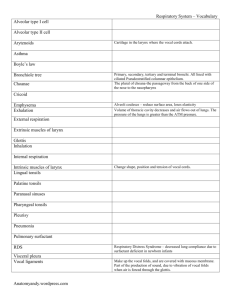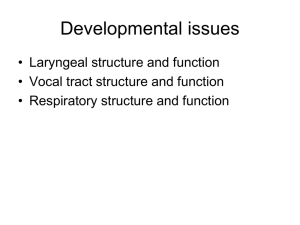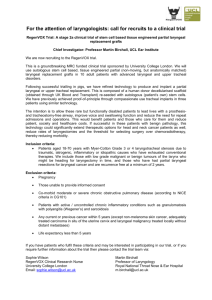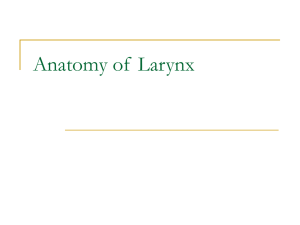후 두 학
advertisement
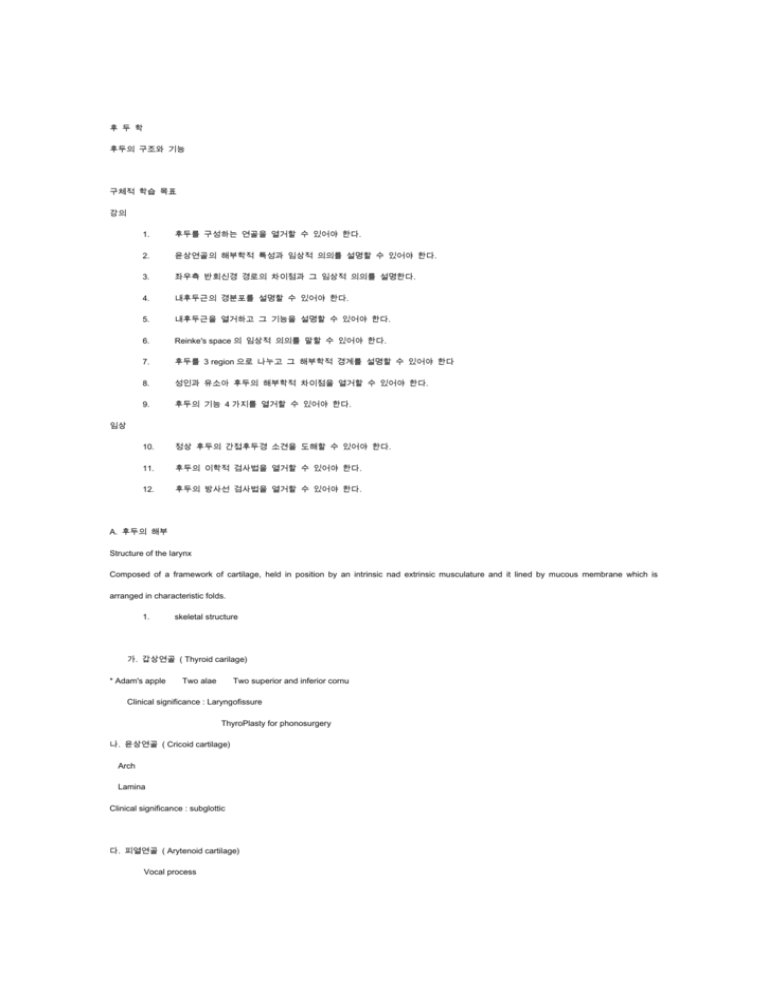
후 두 학 후두의 구조와 기능 구체적 학습 목표 강의 1. 후두를 구성하는 연골을 열거할 수 있어야 한다. 2. 윤상연골의 해부학적 특성과 임상적 의의를 설명할 수 있어야 한다. 3. 좌우측 반회신경 경로의 차이점과 그 임상적 의의를 설명한다. 4. 내후두근의 경분포를 설명할 수 있어야 한다. 5. 내후두근을 열거하고 그 기능을 설명할 수 있어야 한다. 6. Reinke's space 의 임상적 의의를 말할 수 있어야 한다. 7. 후두를 3 region 으로 나누고 그 해부학적 경계를 설명할 수 있어야 한다 8. 성인과 유소아 후두의 해부학적 차이점을 열거할 수 있어야 한다. 9. 후두의 기능 4 가지를 열거할 수 있어야 한다. 10. 정상 후두의 간접후두경 소견을 도해할 수 있어야 한다. 11. 후두의 이학적 검사법을 열거할 수 있어야 한다. 12. 후두의 방사선 검사법을 열거할 수 있어야 한다. 임상 A. 후두의 해부 Structure of the larynx Composed of a framework of cartilage, held in position by an intrinsic nad extrinsic musculature and it lined by mucous membrane which is arranged in characteristic folds. 1. skeletal structure 가. 갑상연골 ( Thyroid carilage) * Adam's apple Two alae Two superior and inferior cornu Clinical significance : Laryngofissure ThyroPlasty for phonosurgery 나. 윤상연골 ( Cricoid cartilage) Arch Lamina Clinical significance : subglottic 다. 피열연골 ( Arytenoid cartilage) Vocal process Muscular process Corniculate cartilage of Santorni Cuneiform cartilage of Wrisberg 라. 후두개 ( Epiglottis) Petiole Tuberculum . Pre-epiglottic space Clinical significance : Important area in spread of laryngeal ca. 2. Elastic structure 가. Quadrangular membrane Aryepiglottic fold Vestibular ligaments 나, Conus elasticus Cricothyroid ligament Vocal ligament Reinke's space : Potential space between the counus elasticus and epithelium/clinical significance : Reinke's edema 다. Thyrohyoid membrane 라. Hyoepiglottic ligament 마, Thyroepiglottic ligament 3. 후두의 근육 가. 외후두근( Extrinsic laryngeal muscles) 후두 하강시키는 근육: sterno-thyroid m sterno-hyoid m omohyoid m. 후두 상승시키는 근육: digastric m. stylohyoid m. geniohyoid m mylohyoid m. 기타: middle constrictor m. inferior constrictor m. 나. 내후두근( Intrinsic laryngeal muscles ) 윤상갑상근 (Cricothyroid muscle: ant. m.) ‥‥‥‥‥ tensor b. 갑상피열근 (Thrroarytenoid muscle: int. m.) ‥‥‥‥ tensor c. 측윤상피 열근 (Lat. cricoarytenoid muscle:lat. m.)--- adductor d. 피열근 (Interarytenoid muscle: trans. m.) ‥‥‥‥‥ adductor e. 후윤상피 열근(Post. cricoarytenoid muscle:post. m.)-- abductor 4. 후두의 신경, 혈관 및 임파관 가. 신경 1) 감각신경 : 성문 상부 상후두신경의 내지(internal br. Of SLN) 성문 및 성문하부 2) 운동신경 : 윤상갑상근 ---- 반회신경 (RLN) 상후두신경의 외지(external br. Of SLN) 기타의 내후두근 반회신경(RLN) 3) 자율신경 나. 혈관 상후두동맥( Sup. laryngeal art.)--- 상갑상선동맥의 분지 하후두동맥( Inf. laryngeal art.)--- 하갑상선동맥의 분지 다. 임 파 관 성대 상부 ‥‥‥ sup. deep cervical Iymph node 로 drain 성대 및 하부 --- inf. deep cervical Iynph node 로 drain Anatomic characteristics of the infant larynx 1. Higher in neck(C4 at birth, C5 at 6yrs, C6-7 at adult) 2. More acute angle between the glottis and epiglottis 3. More soft, flabby and less rigid epiglottis 4. Relatively longer epiglottis(omega shaped) 5. Redundant aryepiglottic folds(closer to the midline) 6. Epithelium and underlying connective tissue are more loosely attached(more easily induced serious edema) B. 후두의 기능 1.하기도의 보호기능 ( Protection of the lower air way) 2. 발성 기능 ( Phonation) 3.호흡 통로로서의 기능( Respiratory tract) 4.흉강 고정의 기능( Fixation of the chest cavity) C. 후두의 검사법 1 간접후두경술( Indirect laryngoscopy) Instruments : Light source Head mirror Laryngeal mirror Mirror image : 좌와 우가 바뀌어 보임. Two vocal cords(folds) Two false cords(vestibular folds) Anterior commissure Interarytenoid region Aryepiglottic fold Rima glottis 2. 직접후두경술 ( Direct laryngoscopy) Direct laryngoscope(Macintosh type , Jackson type, etc . ) Fiber-optic laryngoscope Suspension laryngoscope(Lynch , modified) Operating laryngoscope(Klei nsasser) TelelaryngoscopeVideo-laryngoscopy 3, 방사선검사 ( Radiography) Plain Radiogram TomogramLaryngogram C-T scanning MR 4. Stroboscopy Vocal cord vibration pattern 5.cinematography high speed motion picture 후두의 외상 구체적 학습 목표 강의 1. 후두 외상의 임상적 증상을 열거할 수있어야 한다. 2, 후두 외상을 의심할 수 있는 임상적 sign 을 말할 수 있어야 한다. 3. 내적 후두 외상을 유발시킨 수 있는 가능성이 있는 조건들을 열거할 수있어야 한다. 4. 후두 화상의 종류를 말할 수 있어야 한다. 5. 후두 협착의 종류를 열거할 수 있어야 한다. 6. Glottic stenosis 를 분류할 수 있어야 한다. 임상 7. 후두 외상의 응급치료원칙을 설명할 수 있어야 한다. 8. 성문하 후두 협착의 가장 흔한 원인과 치료 방법을 말할 수 있어야 한다. A. 원인 1. Mechanical injury 가. External : Car accidents Other blunt neck injury Surgical trauma(Cx. of tracheotomy, cricothyroidotomy) 나. Internal : Endoscopic procedure Endotracheal intubation Indwelling nasogastric tube 2 Burns of larynx 가. Thermal burns : Ingestion of hot food or liquid Inhalation of hot air or gas 나. Chemical burn : Lye, ammonia, clorox etc. 3. Irradiation injury 4. Autogenous trauma(voice abuse) B. 임상 증상 The following symptoms are indicative of some drrangement of larynx Dyspnea & stridor Dysphonia & aphonia Cough Hemoptysis & hematemesis Neck pain Dysphagia & hematemesis Distintive clinical signs of external mechanical injury Deformity of the neck Subcutaneous emphysema Laryngeal tenderness Bony crepitus C. 진단 History taking Inspection & palpation Radiogram of neck --- plain film, C-T scan Indirect and direct laryngoscopy D. 치료 Establishment of adequate airway(tracheotomy) Surgical correction if necessary Antibiotics and/or steroids E. 합병증 Infection - perichondritis - necrosis fibrosis-stenosis F. 후두 협착 (Laryngeal stenosis) 1. 분류 Supraglottic stenosis Glottic stenosis Anterior glottic stenosis Posterior glottic stenosis Complete stenosis Mixed type 2. 원인: 가. Trauma External laryngeal injury (1) Blunt neck trauma (2) High tracheotomy Internal laryngeal injury (1) Prolonged endotracheal intubation--- most common (2) Postsvrgical procedure (3) Postradiation therapy (4) Endotracheal burn 나, Chronic infection 다. Laryngeal neoplasm 3. 치료: 가. Glottic stenosisAnterior glottic stenosis: Endoscopic incision, CO2 LASER vaporizationwith insertion of keel Posterior glottic stenosis: Laryngofissure with excision of scar with mucosal flap Posterior cricoid split withcartilage insertion Complete glottic stenosis: Laryngofissure and posteriorcricoid split with stenting 나. Subglottic stenosis Endoscopic methods: Dilation CO2 LASER excision External surgical methods: Ant. cricoid split op.(infant) Ant. laryngofissure with ant.lumen augmentation (costalcartilage, hyoid bone 등) Combined laryngofissure andposterior cricoid division Trough method Cricoid resection with thyro-tracheal anastomosis 애성 구체적 학습 목표 강의 1. 성대결절의 원인과 치료원칙을 설명할 수 있어야 한다. 2, 소아 성대결절의 치료원칙을 설명한다. 3. 성대 폴립의 원인과 치료원칙을 설명할 수 있어야 한다. 4, 삽관 육아종의 치료원칙을 설명할 수 있어야 한다. 5. 후두 유두종의 치료법에 대하여 설명할 수 있어야 한다 6. 후두 keratosis 의 임상적 의의와 치료원칙을 설명할 수 있어야 한다 임상 rl 7. 후두 미세수술의 대상을 열거할 수 있어야 한다. 8, 후두 미세수술의 장점을 말할 수 있어야 한다. 9. 레이저 후두미세수술의 장점을 열거할 수 있어야 한다. A. 염증 질환 (Inflammatory diseases of the larynx with hoarseness) 1. 급성후두염 (Acute laryngitis) 원인 : common cold, inhalation of toxic gas, abuse of voice 증상 :Dryness of throat, hoarseness, cough etc. 진단 :Injection & swelling of mucous membrane on laryngoscopy 치료 : Conservative treatment, voice rest, cold steam inhalation 2. 만성후두염 (Chronic laryngitis) 원인 : Unknown, but one or more sources of persistent laryngeal irritation(chronic infection of upper respiratory tract,vocal abuse, smoking or industrial fumes etc.) 병리 : Hyperemia, interstitial edema, epithelial change, hypertrophy 증상 : Voice change, foreign body sensation on the throat, sputum, pain 치료 : Elimination of cause Endolaryngeal application of silver nitrate Voice rest Expectorants 3. 위축성후두염 (Laryngitis sicca or chronic atrophic laryngitis) 원인 : Marked atrophy of mucosa & mucosal appendage by irradiation, prolonged simple chr. laryngitis, As a part of Sjogren's syndrome, pregnancy 병리 : Decrease of vascularity & fibrosis of the walls of small vessels, Squamous metaplasia, Absence of glandular structures 증상 : Dry throat, persistent cough, Respiratory embarrassment due to crust, Foul odor of the breath 치료 : Furnishing lubrication & moisture to the larynx 4. 후두결핵 (Tuberculosis of the larynx) 원인 : almost always secondary to active pul. Tbc 병리 : Cellular infiltration Multiple small superficial ulcer Perichondritis 증상 : Hoarseness, cough, Pain, referred earache 진단 : Biopsy is essential for diagnosis to rule out malignancy Common site : post. Larynx (interarytenoid fold) Laryngeal surface of epiglottis 치료 : Tbc medication ( not need local laryngeal treatment) voice rest 5. 후두매독 (Syphilis of the larynx) 원인 : Treponema pallidum, now very rare 병리: Mucosa patches during secondary stage summa in the tertiary stage 증상 : Hoarseness, no pain 진단 : Confirmed by serologic test and biopsy 치료 : Penicillin 6. 성대구증 (Sulcus vocalis) Anteroposterioly running sulcus on the free margin of vocal cords which cause dysphonia 원인 Congenital, inflammation 진단 : Indirect laryngoscopy --- depressed furrow unilateral orbilateral Stroboscopy --- glottic chink, loss of mucosal wave 치료 Teflon injection to the cords Suicusectomy Bilateral type l thyroplasty B. Cyst and tumor-like lesions 1. 후두낭종 (Retension cyst) Occur most often where mucous glands are abundant : false cords, ventricle 치료 : Removal under the laryngoscopy 2, 성대결절 (Vocal cord nodule, singer's nodule) A form of chronic laryngitis which is a small mass of inflammatory tissue at the junction of the ant. & middle thirds, usually bilaterly 원인 : persistant vocal abuse or hyperkinetic phonation commonly in professional voice user. 증상 : Breaking voice in high tone, Rapid vocal fatigue, Hoarseness 치료 : Voice rest, Vocal re-education, Removal by laryngomicrosurgery * Surgical treatment is contraindirated for vocal nodille of children. Because a) almost recur b) small size of larynx injury to conus elasticus c) almost spontaneous disappearance at puberty 3. 성대폴립 (Vocal polyp) a. Localized polyp 원인 : Trauma secondary to vocal abuse related to a single episode of vocal strain Most common benign lesion of larynx 병리 : Edematous stroma, dilated vessel and fibrous tissue 증상 : Hoarseness varies according to the size & location usually unilateral 치료 : Removal by laryngomicrosurgery b.Diffuse vocal polyposis(polypoid vocal fold, Reinke's edema) 원인 : Persistent vocal abuse in hyperkinetic, smoking, extroverted individuals 병리 : The margins of the membranous true vocal cords are diffusely involved by edematous tissue masses . The Reinke's space is widended & filled with mucoid material almost devoid of cells, tibrous tissue &blood vessel 증상 : Severe hoarseness is constant 치료 : Removal by laryngomicrosurgery C. 후두육아종 (Granuloma of the larynx) 1. 접촉육아종 (Contact granuloma) Caused by physical trauma secondary to voice abuse. Unilateral or bilateral lesion at or near the tip. of the vocal process . Sx : Hoarseness & painf9fTx : Voice therapy 2. 삽관육아종 (rntubation granuloma) Complication of endotracheal anesthesia Higher incidence in adult female(4 to 1) Predilection site vocal process of arytenoids 치료 : Topical spray of steroid Excision with LASER vaporization of the bed D. Hypertrophic ventricular fold Dysphonia plicae ventricularis E. Chronic epithelial hyperplasia of the larynx 1 Pachyderma larynges A specific entity in which the epithelium of the post. commisure is the site of localized hyperplastic & keratinizing process. Not premalignant lesion Related with smoking & alcohol 병리 : Uniform thickening of epithelium with acanthosis, parakeratosis and hyperkeratosis. Dyskeratosis & cellular atypia are absent 2. Keratosis of larynx A clinical term used to denote a group of a epithelial lesions inwhich an abnormality of growth and/or maturation has occurred. l Leukoplakia hyperkeratosis l Keratosis with cellular atypia l DyskeratosisRelated with carcinoma of larynx 원인 : Exact cause is unknown Smoking, vocal abuse, chronic laryngitis 증상 : Hoarseness Almost enclusively in males 치료 : Cessation of smoking and other causative agents Excision by laryngomicrosurgery(stripping) or by laser vaporization, Periodic examination 미세후두수술 (Laryngomicrosurgery: Kleinsasser) Laryngeal surgery using surgical microscope & under the operating laryngoscopy. Indication 1) removal of benign mass or cyst 2) treatment ft diagnosis of premalignant lesion or early Ca 3) endolaryngeal microscopy extent of lesion, expecially Ca. 4) intracordal injection : Teflon injection for cord paralysis 5) treatment of laryngeal web, * Advantages of COa LASER Laryngeal Surgery 1) Bloodless surgery 2) Aseptic surgery 3) Precise surgery 4) Less surgical edema 5) Rapid wound healing 6) Less postop. Pain F. 양성종양 (Benign tumors) 1. 후두유두종 ( Laryngeal papilloma) Most common benign tumor of the larynx, and occurs in patients of all ages. 원인 : May be, virus Seem to be related with hormonal changes 병리 : Usually involving the true cords but may involve supraglottic and subglottic ateas.I n juvenile, more multiple. 증상 : Hoarseness Dyspnea 치료 : Repeated laryngoscopic removal , Laser vaporization, Cryosurgery, Ultrasound therapy Interferon injection or spray 2. Chondroma 3, Fibroma 4, Adenoma 5. Granular cell myoblastoma 6. Hemangioma G. 악성 종양 (Malignant tumor of the larynn): 제 31 장 참고 후두의 신경마비 구체적 학습 목표 1. 상후두신경의 internal branch 와 external branch 의 차이점을 말할수 있어야 한다. 2, 내후두근 중 반회신경의 지배를 받지 않는 근육의 이름과 그 근육의기능을 말할 수 있어야 한다. 3. 성대마비로 초래될 수 있는 성대 위치의 종류를 열거할 수 있어야한다. 4, 편측 반회신경마비를 일으킬 수 있는 원인들을 열거할 수 있어야 한다. 5. 편측 반회신경마비의 치료 원칙을 말할 수 있어야 한다. 6. 양측성 성대마비의 증상과 그 치료법을 열거 할 수 있어야 한다. 7. 상후두신경 마비의 임상 양상을 설명할 수 있어야 한다. A. Vagus nerve(Mixed nerve) 1. Motor fibers : From nucleus ambigus to musles of the soft palate pharynx and intrinsic muscles of the larynx 2, Parasympathetic fibers : From the dorsal motor nucleus of the vagus to the thoracic and abdominal viscera. 3.Somatic sensary fibers(of unipolar cells): Peripheral branches via the auricualr branch to the external ear canal and part of the ear. 4. Visceral sensory fibers(of unipolar cells): Peripheral branches to the pharynx, larynx, trachea, esophapus and the thoracic and abdominal viscera and a few special afferents to taste buds in the epiglottis region. 상후두신경 (superior laryngeal nerve) internal branch sensory innervation to the laryngeal cavity external branch Motor supply to critothyroid muscle 반회신경 (Inferior laryngeal neue or recurrent laryngeal nerve) Motor imiervation to all the intrinsic muscles except the cricothyoid muscle. Sensory innervation to the lower part of the larynx including true vocal cord. C. Paralysis of the v,ocal cords Types 가. Midline paralysis, unilateral 나 Incomplete paralysis, unilateral 다 Midline paralysis, bilateral 라 Incomplete paralysis, bilateral 마. Complete paralysis, both cords 1) Midline or immediate abduction position 2) Immediate adduction or extreme opening of paralysed cord 3) So-called cadaveric position(halfway between adduction and abduction) 1. Central paralysis 가. Cortical paralysis Each side of the larynx receives a motor supply from the both sides of the cerebral cortex. It is very unusual to see a lrtyngeal paralysis by a cortical lesion. 나. Bular palalysis Multiple sclerosis Syringomyelia Brain tumor Vascular thrombosis 2, Peripheral paralysis 가. Vagus trunk above the origin of the superior laryngeal nerve 원인 : Tumors of the base of the brain and in the region of the jugular foramen, eg. carcinoma of nascpharynx 증상: Cord is flabby owing to loss of tone in cricothyroid muscle Aspiration pneumonia due to sensory loss 나. Unilateral recurrent laryngeal nerve paralysis 원인 : 1) Surgical trauma to the nerve Tyhrodectomy most common cause cardiac surgery and other chest s urgery 2) Pressure or infiltration to nerve Cardiac hypertrophy Aortic aneurysm, pericarditis Ca. of thyroid, esophagus, bronchus or mediastinum Tbc. inflammation at the apex of the Lt. lung 3) Toxic neuritis Viral infection(influenza) Alcohol Lead or arsenic etc. 4) Idiopathic(10-20%)3θ0증상 : Normal or very hoarse voice depending on the postion & tension of the vocal folds. Usually weak and air spilling type of voice, later better voice could be possible by the compensation of the normal cord 치료 : Wait ft see at least 6 months Surgical Tx -- Teflon_injection ( silicon, collagen) Median fixation of cord e.g. Tyhroplasty type I or reversed King op. 다. Bilateral abductor paralysis It is of great clinical importance. 원인 : Usually by extensive thyroid surgery with injury of both recurrent laryngeal nerves. 소견 : Paralysis of both vocal cords near the median line 증상 : The voice is good though weak Stridor on exertion Dyspnea 치료 : Tracheostomy, sometimes for lifesaving Arytenoidectomy King op.(arytenoid is rotated and fixed laterally) Biomedical laryngeal pacemaker 라. Superior laryngeal nerve paralysis 원인 : Usually secondary to thyroidectomy of supraglottic laryngectomy 증상 : Lowered voice Posterior commisure deviates to the paralysed side Paralysed cord is flabby, bowed and lower 진단 : Cricothyroid approximation

